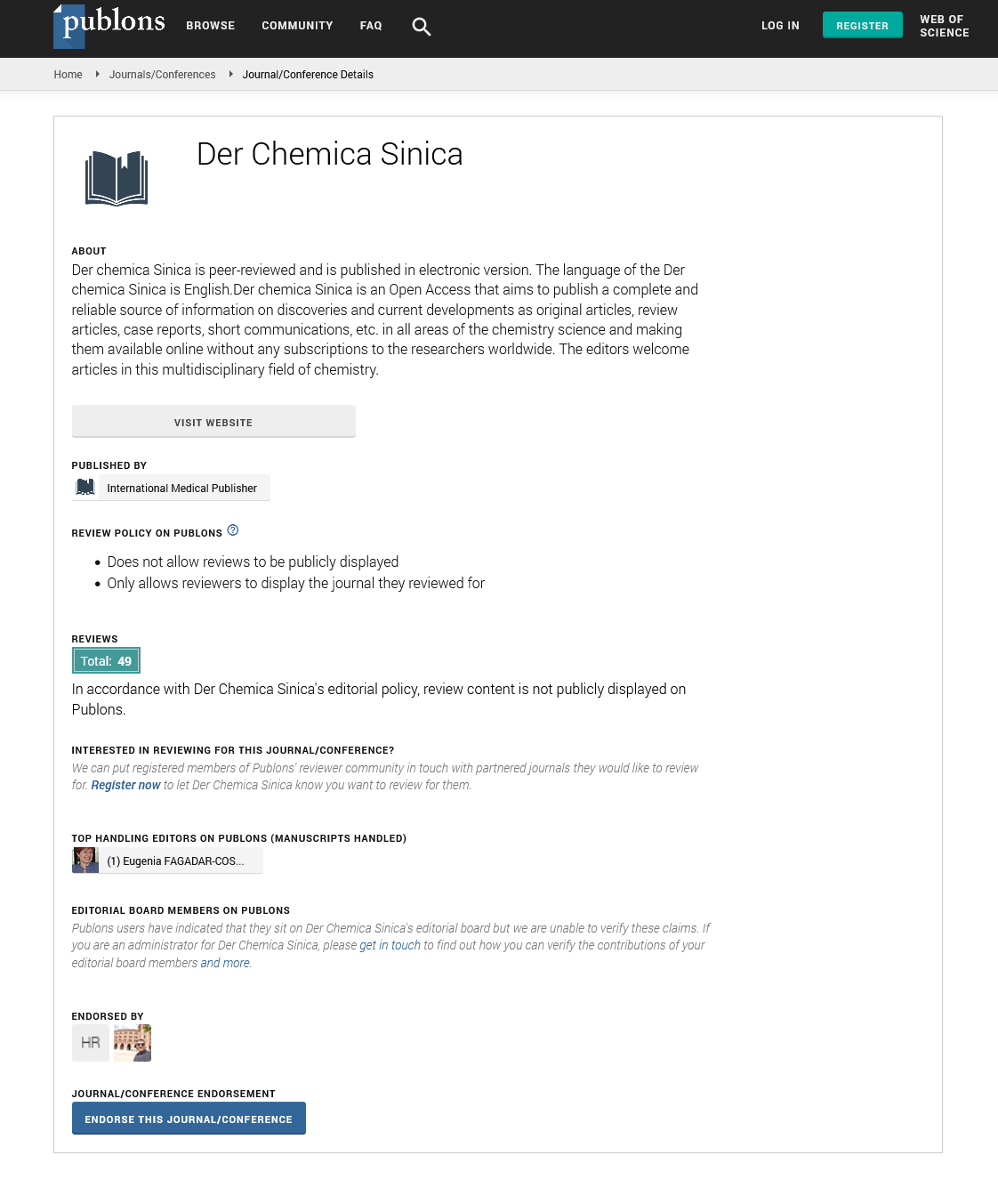ISSN : 0976-8505
Der Chemica Sinica
Abstract
Synthesis and studying of antimicrobial and antioxidant activity of some novel furocoumarin and benzofuran derivatives containing thiazole moiety
Treatment of (4-methoxy-6-hydroxybenzofuran-5-yl)methyl ketone (1) with 2-aminothiazole or O-tolidin in presence of formaldehyde gave Mannich bases (2a,b). Claisen condensation of [4-methoxy-5-acetyl-6-hydroxy-7-((thiazol-2- ylamino)methyl)] benzofuran (2a) and [4-methoxy-5-acetyl-6-hydroxy-7-((3,3'-dimethyl-4'-aminobiphenyl-4- ylamino)methyl)]benzofuran (2b) with diethyl carbonate in presence of sodium powder gave the corresponding -5- hydroxyfurocoumarins (3a,b) respectively. Treatment of 3a with cinnamaldehyde under different conditions was discussed. Thus, when 3a was refluxed with cinnamaldehyde for 20 minutes, 4-methoxy-5-hydroxy-6-[3'-hydroxy-1'- phenylprop-1'-en-3'-yl)-9-((thiazol-2-ylamino)methyl)]furo[3,2-g][1]benzopyran-7(H)-one (4) was formed. While, refluxing of 3a with cinnamaldehyde for 3hrs.a dimer compound of 3,3-bis[4'-methoxy-5'-hydroxy-7'H-7'-oxo-9'- ((thiazol-2-ylamino)methyl)furo[3,2-g][1] benzopyran-6'-]-1-phenyl prop-1-ene (5) was obtained. Chlorination of 3a by phosphorusoxychloride gave 5-chlorofurocoumarin derivative (6) which reacted with sulphadiazine to yield 7. On the other hand, bromination of 2a in chloroform gave 5-bromoacetyl benzofuran derivative (8) which condensed with N-acetylthiosemicarbazide or thiourea to furnish the corresponding 2-(N-acetylhydrazino)thiazole and 2- aminothiazole derivatives (9), (10) respectively. Interaction of 10 with each one of cinnamaldehyde or 3- aminophenacylbromide gave Schiff base (11) and imidazolothiazole derivative (12). Condensation of the latter compound 12 with triethyl orthformate gave 13. Compounds 2a, 3a, 4, 5, 8, 9 and 11 demonstrate antimicrobial activity against the microorganisms E.coli, F.streptococcus and A.flavus. In addition compounds 2b, 3b, 8 and 10 illustrate antioxidant activity by using free radical scavenging activity test.
Author(s): Sadia A. Hessein and Atteyat A. Labib
Abstract | PDF
Share This Article
Google Scholar citation report
Citations : 6019
Der Chemica Sinica received 6019 citations as per Google Scholar report
Der Chemica Sinica peer review process verified at publons
Abstracted/Indexed in
- Google Scholar
- Open J Gate
- Genamics JournalSeek
- China National Knowledge Infrastructure (CNKI)
- Directory of Research Journal Indexing (DRJI)
- Publons
- MIAR
- International Committee of Medical Journal Editors (ICMJE)
- Serials Union Catalogue (SUNCAT)
- Geneva Foundation for Medical Education and Research
- Secret Search Engine Labs
- Euro Pub
- CAS (Chemical Abstracting Services)
- University of Barcelona
Open Access Journals
- Aquaculture & Veterinary Science
- Chemistry & Chemical Sciences
- Clinical Sciences
- Engineering
- General Science
- Genetics & Molecular Biology
- Health Care & Nursing
- Immunology & Microbiology
- Materials Science
- Mathematics & Physics
- Medical Sciences
- Neurology & Psychiatry
- Oncology & Cancer Science
- Pharmaceutical Sciences
